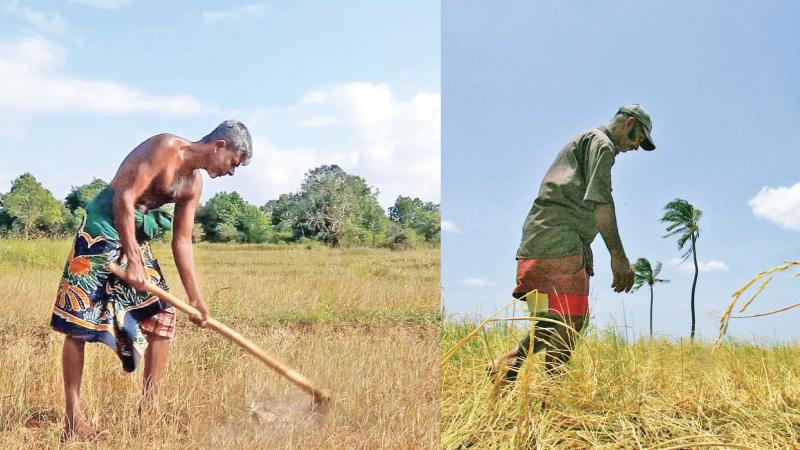
As short-term (3-10 day) weather forecasts has proved less effective in agricultural planning, the Department of Meteorology (DOM) and the Natural Resource Management Centre (NRMC) (which houses the Agro-met Office) in collaboration with its line agencies have taken steps to minimise the impact of climate change on agriculture, Prof. Buddhi Marambe of the Department of Crop Science, Faculty of Agriculture, University of Peradeniya said.
 “Release of Agro-Met Advisories (AMAs) by the NRMC and the Seasonal Climate Forecasts issued by the DOM at the beginning of the cultivating seasons are such key initiatives,” he said, adding that farmers in Sri Lanka report that they are observing these changes and that their historic weather knowledge and experience are progressively less useful in the agricultural planning process, due to rapid changes in the climate.
“Release of Agro-Met Advisories (AMAs) by the NRMC and the Seasonal Climate Forecasts issued by the DOM at the beginning of the cultivating seasons are such key initiatives,” he said, adding that farmers in Sri Lanka report that they are observing these changes and that their historic weather knowledge and experience are progressively less useful in the agricultural planning process, due to rapid changes in the climate.
“The more frequent short-term weather forecasts has provided limited assistance for planning in the agricultural sector. While acknowledging these efforts, they should be further strengthened to ensure direct reach of such information to the practitioners using available technologies such as mobile services,” Prof. Marambe said adding that the agro-met information is disseminated at provincial level hoping that it will reach farmers. But there is no way to monitor as to whether the information reaches the farmer in time.
However, availability and reliability of long term weather data has always been a challenge together with the skills of the mathematical models used for forecasting, on the accuracy of predictions. Issuing seasonal climate forecasts at least a month before the commencement of the season, could assist farmers and policy makers to develop improved climate risk management strategies that would lead to ensuring food security.
“Climate is one of the main determinants of agricultural productivity in Sri Lanka. Despite its relatively small extent, the Sri Lankan landmass exemplifies a variety of climatic conditions. The overwhelming scientific research has provided evidence of two general trends in Sri Lankan climate.
For example, increasing ambient temperatures resulting in temperature and heat stress, and frequent and severe occurrence of droughts and floods, would strongly affect crop and animal production, hence, the food security,” Prof. Marambe said.
While certain parts of the island is battered by heavy rains others especially in the North and North Central provinces are hampered by severe drought bringing farming, the only livelihhod for hundreds of families to a standstill.
“Changes in the monsoon rainfall pattern and an increase in minimum air temperature are likely to be the two key factors that will affect food production in principal growing regions,” Prof. Marambe said.
The four rainfalls experienced during a 12-month period in Sri Lanka are: (1) First Inter Monsoon (FIM; March – April), (2) South West Monsoon (SWM; May – September),(3) Second Inter Monsoon (SIM; October – November) and (4) North East Monsoon (NEM; December – February). The rainfall during the Yala cultivating season is received from FIM and SWM, and that of the Maha season from SIM and NEM.
“We are now in middle of the Yala cultivating season and experiencing SWM rains in the south western part of the country, which is the usual case.The SWM rain decreases rapidly towards the higher elevations, and the lowest rainfall during this period is usually recorded from the Northern and South-Eastern regions. This is because when the SWM crosses over these mountain regions it has already exhausted most of the water vapour in the windward side of the Central highlands. Hence, we experience drought in the northern part of the country during the Yala season,” Prof. Marambe said.
According to the Principal Scientist at the Natural Resource Management Center (NRMC) of the Department of Agriculture, Dr. Ranjith Punyarwadena, the intensified drought in the dry zone is due to a combined effect of low rainfall experienced in the Maha season (2018/2019) affecting the carryover capacity of reservoirs to the following season, and a failed FIM in 2019.
A good Maha season helps in having 20-30% carryover capacity in reservoirs towards the Yala season, enabling the cultivation of about 40% of the paddy lands in the dry zone. Thus, the failure of two consecutive rainfall seasons is the main reason for intensified drought in Northern and North-Eastern parts of the country experienced at present.
Sri Lanka had two bad years in terms of below normal rainfall in 2016 and 2017, severely affecting the growth rate of agriculture (-4.2% in 2016 and a further contraction by -0.8% in 2017). However, owing to the good weather conditions, the overall agriculture sector bounced back in 2018 having the highest growth rate of 3.9% compared to that of industry and service sectors. This is enough proof to show how the weather patterns can affect Sri Lankan agriculture and the overall development agenda
The National Climate Change Policy of Sri Lanka of 2012,and the National Adaptation Plan (NAP) for Climate Change Impacts of 2016 clearly endorse the need of appropriate adaptation strategies in order to reduce the impacts on crop and animal production while ensuring national level food security.
For development investments to become resilient to anticipated climate change, it is important to understand the nature of vulnerability from a sub-national perspective and reflect this in development strategies that are formulated at different administrative levels. With the global pledge in achieving Sustainable Development Goals (SDGs) by 2030, and Paris Agreement has been entered into force, a new approach for long-term sustenance in food security is a necessity to improve the productivity and efficiency of agriculture and food systems while reducing negative environmental impacts.
